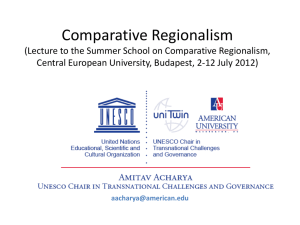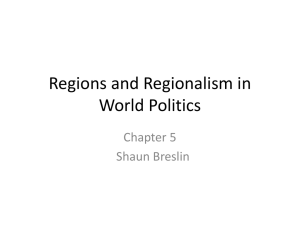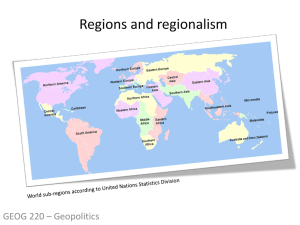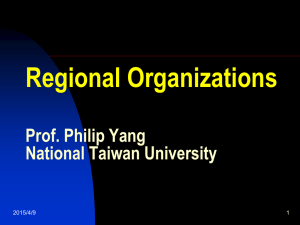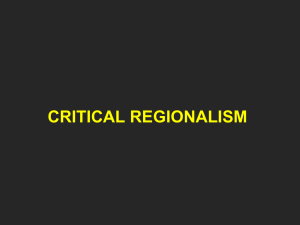The Political Economy of Regionalism
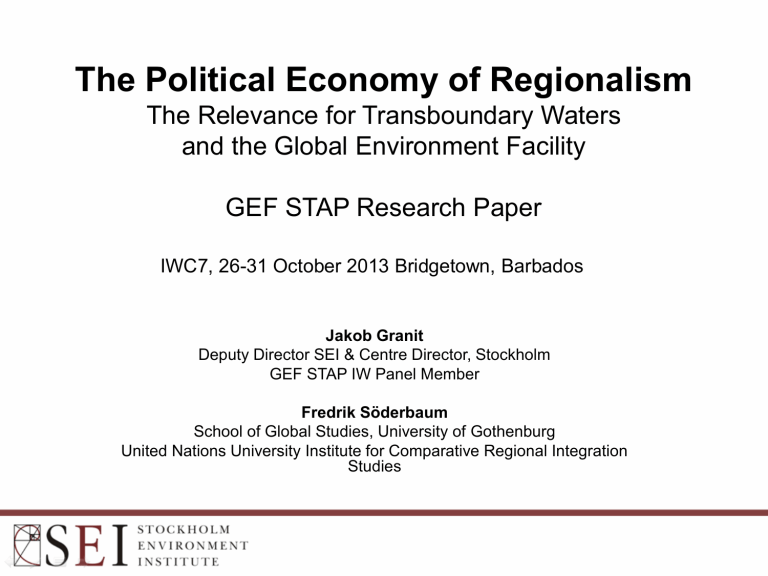
The Political Economy of Regionalism
The Relevance for Transboundary Waters and the Global Environment Facility
GEF STAP Research Paper
IWC7, 26-31 October 2013 Bridgetown, Barbados
Jakob Granit
Deputy Director SEI & Centre Director, Stockholm
GEF STAP IW Panel Member
Fredrik Söderbaum
School of Global Studies, University of Gothenburg
United Nations University Institute for Comparative Regional Integration
Studies
Research question & objectives
“Can transboundary/international water management be more efficiently & sustainably supplied if it is more strongly linked to the broader political economy of regionalism?”
Objectives:
• to provide a scientifically based overview of the political economy of regionalism
• to explore the relevance of regionalism for transboundary water management in general and GEF’s activities more specifically
• Mixed methodological approach
– Scientific & policy literature reviews; empirical evidence from
GEF terminal evaluation reports, workshop and peer review
Definitions
• Regionalism
– The common objectives, values and identities that lead to region-formation and regional cooperation within a given geographical area (micro or macroregion)
• Political economy
– The interaction between public authority (institutions
& governance) and the economy and markets
• Drivers, incentives, behaviours
The governance & management challenge of transboundary water resources
• The “free rider” problem
• The “weakest link” problem
• The “summation” problem
The International Task Force on Global
Public Goods, 2006
UNEP primary watersheds map
• Olsson “theory on collective action (65)
• Hardin, “the tradegy of the commons” (68)
• Ostrom, ”self organization”
(90)
Transboundary/IW resources management is in itself a regional public good
• Public goods are available to all and consumption of the public good by one party does not reduce the amount available to others to consume (non-excludable)
• PGs cannot be adequately provided by individual countries acting alone
– Services: provisioning; regulating; cultural; supporting
Granit 2012, Phillips et. Al. 2008; The International
Task Force on Global Public Goods, 2006; MEA 2005
Re-emergence of regionalism (new regionalism)
• Old regionalism linked to cold war context
– Bi-polar world order, introvert
– State actors
– EU as a model
• New regionalism linked to globalization
– Multipolar world order, extrovert
– Triple helix (governments, private sector, academia & civil society)
– Multiple actors & stakeholders
Regionalism takes many shapes and forms
• Several regional ‘scales: continent, macro-region, subregions, micro-regions
EU - EU BSR Öresund region
OAS – CARECOM - Carribean
LME
AU – COMESA – EAC – LVBC
• Different types of regionalism
Security; economic; social; environmental
Or a combination of the above
STAP Research Paper
Typology of Regional Frameworks
Organization Network
Specialized, sectoral or functional
Transport organization
Development bank
River basin organizations
Multipurpose
Development community
Economic Union
Political union
Research network
Civil society network
Power pool
Growth triangle
Development corridor
Illustrative cases in the research paper
• Baltic Sea region
– From a uniting sea to a divided and back
• End of cold war
– Persistent common environmental challenges
• Linked to lifestyles: energy; transport & agriculture
– New EU BSR stratey combines the environment, economic growth and connectivity in the region
• Common Vision
– National and regional action
• Sava River basin, South-East Europe
• CARICOM, Caribbean
•
Iullemeden Groundwater Aquifer System, West Africa
• East Asian Seas
•
Red Sea and Gulf of Aden
• Caspian Sea Environment
The comparative advantage of regionalism 1
• Link state and non-state actors at various levels over time
(‘nested governance’)
• Provide frameworks for multi-country cooperation
– Norms, trust, institutions, reciprocity, transaction costs, reduce power games
– Agreeing on a “common vision”
• Ensure (national) political commitment and buy-in
– Credibility of national reforms through ‘lock-in’
– Common goals, targets, rules and regulations, M&E
The comparative advantage of regionalism 2
• Larger and more competitive markets
– Economies of scale and pooling of resources
– Better utilization of factors of production and resources
– Increased FDI and capital flows
• Acting as a block in a globalized world
• Conflict resolution & stability
– Reduce fragmentation and
“Balkanization”
WDR 2009, World Bank
Regionalism is not the solution to all issues
• Many barriers to regionalism: outside and inside a region
• ROs can be costly, ineffecient, dysfunctional
& even manipulated if not well managed and owned
Research findings generic on PE of
Regionalism and TB waters
1. Collective action in the IW space is dependent on functioning national institutions & viable regional governance frameworks
2. Specialized regional organizations and frameworks are able to enhance cooperation when the incentive structure is clear at the national and regional levels
3. Multi-purpose regional governance frameworks will facilitate a higher degree of political coordination and leadership in complex and politicized regions
Research findings specific on PE of
Regionalism and GEF IW
4. Efforts to promote regionalism need to be synchronized with national concerns, incentives and benefits
5. The broader regional political and economic context including the logic of states-led regional organizations should be addressed in regional GEF strategies
6. A regional governance baseline analysis must be undertaken when planning transboundary water interventions
– Problematize the role and function of regional institutions




